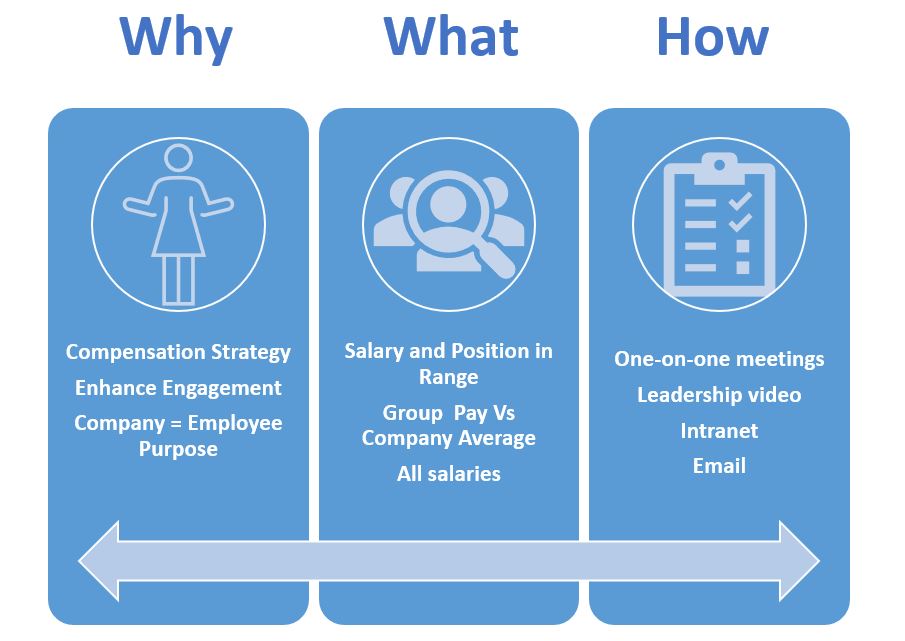In recent years widespread social-justice movements are demanding pay equality. And in today’s war for talent, pay transparency is critical for employee acquisition and retention. While President Biden has made closing gender and racial pay gaps a priority, so far progress has been mostly limited to the federal workforce. Instead, states and municipalities are passing laws requiring disclosure of pay ranges to job applicants, a trend that is accelerating. Colorado, California, and most recently New York City have enacted pay transparency laws.

Although regulatory action is certainly driving more pay transparency, there is growing evidence that employers adopting their own pay transparency programs have a competitive advantage. How? Job seekers gain a clearer idea that the employer values pay equity and has inclusive hiring practices. In addition, being upfront about compensation saves time during the hiring process by eliminating candidates who do not match salary expectations.
In fact, 6 out of 10 job candidates say they are more likely to apply to a job when salary information is shared, according to the 2021 Employee Expectations in Hiring survey by compensation software firm beqom. Millennial and Gen X workers have a higher expectation than do Gen Z or older Boomers.
Perception Meets Reality
Despite the apparent advantages businesses accrue from pay transparency practices, many are reluctant to act. Some fear that when salary ranges are posted all employees will expect to be paid at the high end of the scale. Others are concerned they will lose their best talent to competitors.
A recent salary.com survey of over 1,000 participants, representing companies large and small from across the U.S, finds that just over one-third (34.3%) of respondents share salary ranges with job applicants or employees. In sharp contrast, 73% of employees say it is important for them to know they are paid fairly in comparison to their colleagues in similar roles.
Putting Pay Transparency into Practice
Wherever employers land on the pay transparency issue, they may find that the goodwill generated with workers and job candidates far outweighs the potential risks. Following are six recommended steps to achieve pay transparency:
- Understand Pay Transparency Perceptions – An employee survey or in-depth conversations with managers and staff provides a benchmark for future planning. Make sure to address what employees know about current pay practices, whether they believe they are paid fairly, and how they view opportunities for advancement. Asking the right questions will also reveal where there are gaps in understanding. These research findings set the stage for organizational compensation plans, newly enacted pay transparency initiatives, and communications effectiveness.
- Define Pay Transparency Goals – In addition to improved hiring and retention success, there are other considerations impacting transparency goals. First, linking transparency objectives to the company mission and purpose helps employees understand their role in the workplace and how they contribute to the greater good. Second, a better understanding of compensation programs leads to improved productivity and performance. Employee engagement and support for DEI implementation can also be achieved. At least initially, establish only one or two goals. Then devise specific measures to determine if goals are attained.
- Decide What to Communicate – Once the compensation philosophy and plan are defined, outline specific information to communicate to prospects and employees. Getting the balance right between transparency and privacy is key. In that respect, give people information on how pay is determined (both salary and incentive programs); sources of competitive information and pay opportunity relative to market; the salary range for each person’s position and job level; and where and why they are paid within the range. Should a company decide to go deeper, full transparency may include publishing all company salary ranges by group (gender, national origin, etc.) relative to CEO compensation or average employee pay. Communication around DEI implementation can also be developed.
- Have HR Take the Lead – The company’s human resources (HR) team will be tasked with rolling out and communicating the compensation program. Most organizations thoughtfully develop communications materials that align with company policies. They also use the full scope of communications channels and tools at their disposal: the company intranet, Town Hall meetings, in-person or virtual presentations, leadership videos, tool kits, newsletters and more to ensure that every employee understands the pay philosophy and program.
- Support Managers with Training – Since employees rely on their managers to answer questions or address issues on a day-to-day basis, they are essential to pay transparency success. Historically, having conversations about compensation has not been easy for them. Coaching or training will help managers integrate pay discussions with guidance on each employee’s development plan. In addition, role playing can prepare managers on how to answer tough questions or deal with confrontational situations.
- Set Metrics to Evaluate Program Effectiveness – At least annually, a company needs to determine its employees understanding of their compensation programs using measures established in Step 2.
Final Thoughts
Legal requirements to better communicate to job candidates and employees about pay and future compensation are mounting. Still, there are many more compelling reasons to proactively address pay transparency.
First, organizations that openly communicate compensation enjoy higher trust leading to higher retention. Second, pay transparency promotes pay equity and equal opportunity. Finally, it leads to better employee engagement and job satisfaction. These are all practices that Top Workplaces have in common, and they are increasingly important to employees navigating the workplace in a post-pandemic world.
Contact Us
Neil Lappley is a leading expert on pay delivery and competitiveness compensation practice issues in the Midwest. He consults with clients on compensation design matters for executives and salaried employees, assessment of pay competitiveness, incentive compensation, conduct of compensation surveys, and salesforce compensation. He authors a widely distributed monthly newsletter and presents at state and local compensation and human resource conferences. Connect with Neil at (847) 921-2812 or nlappley@lappley.com.



